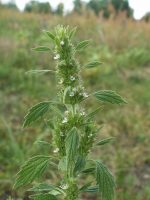 Native to southern Europe, central and western Asia, and North Africa, this herbaceous perennial is a member of the mint family, Lamiaceae, that also includes basil, rosemary, and beebalm. Plants grow 10-18″ tall and have branching, hairy stems that are square in cross section. The soft, hairy, gray-green leaves are oval to round and up to 2″ long. They have a crinkled texture, toothed margins, and woolly underside. Dense whorls of white, tubular, two-lippped flowers appear in summer in the leaf axils of the upper part of the main stems. Horehound has been used as a medicinal herb to treat respiratory problems and as a culinary herb to flavor candy and beverages. The flowers attract bees but the plant can become weedy and invasive. The genus name, Marrubium, is the ancient Roman name for the plant. The specific epithet, vulgare, is the Latin word meaning common. This plant is oftern called white horehound to distinguish it from black or stinking horehound (Ballota nigra), a strong smelling weed that can be toxic in large quantities.
Native to southern Europe, central and western Asia, and North Africa, this herbaceous perennial is a member of the mint family, Lamiaceae, that also includes basil, rosemary, and beebalm. Plants grow 10-18″ tall and have branching, hairy stems that are square in cross section. The soft, hairy, gray-green leaves are oval to round and up to 2″ long. They have a crinkled texture, toothed margins, and woolly underside. Dense whorls of white, tubular, two-lippped flowers appear in summer in the leaf axils of the upper part of the main stems. Horehound has been used as a medicinal herb to treat respiratory problems and as a culinary herb to flavor candy and beverages. The flowers attract bees but the plant can become weedy and invasive. The genus name, Marrubium, is the ancient Roman name for the plant. The specific epithet, vulgare, is the Latin word meaning common. This plant is oftern called white horehound to distinguish it from black or stinking horehound (Ballota nigra), a strong smelling weed that can be toxic in large quantities.
Type: Herbaceous perennial
Bloom: Small, white, tubular, two-lipped flowers in whorls in leaf axils in summer
Size: 10-18″ H x 12″ W
Light: Full sun
Soil: Average to lean, dry, well-drained, acidic
Hardiness: Zones 4-7
Care: Restrict spread by removing flowers before seed formation
Pests and Diseases: None of significance
Propagation: Seed, basal cuttings, division
Photo Credit: Wikimedia Commons